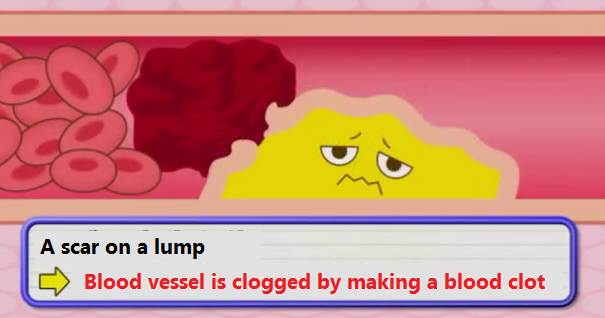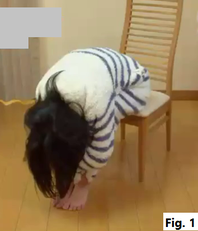|
What is the cause of swelling, tiredness and cramps of your legs?
There are valves in veins. If the valves work properly, blood in your legs goes up without returning. But if the valves in your legs are broken, blood can’t go up and returns to your legs. Water in blood oozes out into your legs, causing swelling and tiredness in your legs. Cramps of the legs at night are related to being unable to send back waste properly. Broken valves will not recover. If the broken valves are left as they are, other valves will be broken and the damage will spread out, leading to the lower extremity varicose vein and inflammation of the skin. What is the solution? Compression stockings. If you stand for a long time, blood tends to build up in the lower part of the legs and the veins become larger making a gap in valves which should be closed. More blood falls down damaging the valves, resulting in the deformation of the valves. Therefore, the problem is the enlargement of the veins. Wearing compression stockings tightens up the vein, decreasing the gap in valves. If the condition is in an early stage, it is expected that the broken valves will be fixed by wearing the stockings. How do you know if the valves of your legs are broken or not? How to find backflow of veins: 1. Stand – if you stand, blood stays in your lower body and the vein with broken valves floats up on the skin. 2. Wait for a minute – it takes about a minute for blood to build up. 3. Touch – even if veins with broken valves are located somewhere difficult to find with your eyes, touching makes finding the swelling of the vein easier. If you find swelling of veins (varicose veins) or thin red web-like lines of blood vessels (spider veins), there is backflow of veins. In that case, get and try compression stockings with variable pressure gradients. If the condition is severe, there is a laser surgery for varicose veins. Heat from a laser heats up the inside of varicose veins and closes them. Blood flows in the other veins.
0 Comments
What is the nutrient which will be the key to make your heart younger?
That is IRON. Iron becomes red when combined to oxygen. Our body contains 3 to 5 g of iron. Hemoglobin containing iron carries oxygen to the whole body. Previously, the most important role of iron was considered as carrying oxygen to the whole body. However, it has turned out that iron is playing an important role for the heart. Our muscle doesn’t move without iron. The heart is a mass of muscles so it doesn’t move well if iron is insufficient. There is a possibility that the increase of heart failure is related to lack of iron. What do you need to eat to take iron efficiently? Iron is contained a lot in liver, red meat and animal heart. Decrease of eating meat with age is considered as a cause of insufficient iron. 68 years old female whose iron is 34.8 ng/ml (baseline 100 ng/ml) is possibly in pre-heart failure condition. Her family runs a bakery. She starts working at 6 am and the morning is the busiest time because they have to prepare 300 breads. She has breakfast at 8 am. She eats the leftover breads of yesterday, some broccolis and lotus roots. Lunch time is busy with customers so she has her lunch at 3 pm. She eats some ham & egg sandwiches, a cup of soy source soup with vegetables and fish dumplings, some vegetables boiled down in soy source, and an orange. Her work is over at 6:45 pm. She eats brown rice, grilled salmon, salad, boiled vegetables and a persimmon. The amount of iron she takes from her meals is 6.1 mg which is lower than the average of 60s female in Japan, 8.1 mg. How much iron does she have to take in order to make her heart younger? She starts to take more than 10 mg of iron a day for 10 days. She prepares a dish made of dried daikon radish, soy bean products (fried bean curd) and Enoki mushroom, which she can store for a few days, and also she can take more than 10 g of iron a day if she eats 3 times. To accomplish it, she cooks and eats various kinds of dishes mixing the prepared dish. 10 days later her iron increased from 32.4 to 69.2 ng/ml. She also tried 6 minutes walking test. Last time she walked 580 m but couldn’t accomplish the baseline 586.9 m. This time she walked 608 m which is 28 m more than the last time. Do you know how many times our heart beats a day?
The answer is about 100 thousand times. The heart doesn’t stop any moment and if you live until 80 years old, your heart beats about 2.9 billion times in your life. So it is not surprising that our heart becomes weaker with age. The healthy heart sends out blood to the whole body by the repeats that a left ventricle contracts and expands flexibly. On the other hand, if the function of the heart becomes weak, the left ventricle is not able to contract and expand enough to send out sufficient blood to the whole body. This is the condition called heart failure. Once you become this condition, you experience shortness of breath even if you climb up stairs a little or you tend to easily get tired. Before we notice, people with pre-heart failure (hearts become as weak as just before heart failure) are dramatically increasing. The cause attracting attention is lack of nutrient which becomes the source of required energy for the heart. So what is the source of the energy for the heart? It has not been proven because it is the latest medical research, but there are not a few elderly people who are short of the nutrient potentially. 8 elderly people who checked the amount of the nutrient had 6 minutes walking test to check the performance of the heart. 3 of the 4 people who were short of the nutrient couldn’t walk the baseline distance within 6 minutes and 1 of the 4 people who were not short of the nutrient couldn’t walk the baseline distance. This tells that there is an obvious difference about the heart function. In a research, 300 people who showed the weakness of heart such as shortness of breath were gathered and the nutrient becoming the source of the energy was given for a year. As a result, their heart function was dramatically improved. What is the nutrient which will be the key to make your heart younger?
Q9. The blood vessel which was damaged before can recover. (A) True (B) False A9. (A) True It had been thought that damaged blood vessels could not recover, but according to the newest research, it turned out that recovering was possible. The most inside layer of the blood vessel can recover at a certain level by the improvement of the lifestyle. The foods which are expected to help the damaged blood vessels recover are miso, cheese and onions in addition to balanced meals. LTP (Lactotripeptides) is a kind of amino acids recently discovered contained in miso and cheese and it is expected to lower blood pressure and prevent arteriosclerosis. Quercetin is a flavonol that prevent active oxygen damage the blood vessel with antioxidant action and also makes the blood flow better. Quercetin is contained in onions a lot. If you peel the skin of onions and place them under the sun for about a week, the amount of quercetin becomes 3 times more. So a recommended recipe is miso soup with onions and cheese.
Q5. Why do stroke and heart attack occur most in winter?
(A) Because blood vessels contract with cold. (B) Because blood flow becomes faster with cold. A5. (A) Because blood vessels contract with cold. Blood plays a very important roll to control the body temperature. For example, when you go to a warm place, your body tries to release heat enlarging the blood vessels to lower the body temperature. On the contrary, when you go to a cold place, your body tries not to release heat contracting the blood vessels to keep the body temperature. This is similar to the relationship between cars and roads. Assuming the warm place is 3 lanes and the cold place is 1 lane, when cars come from 3 lanes to 1 lane, traffic jam happens at 1 lane. That is like blood tends to be clogged if it is cold because the blood vessel becomes narrower. That is why stroke and heart attack tend to occur more in January and February (winter). Q6. Who has the risk to have stroke or heart attack (myocardial infarction) during sleep? (A) A person who snores (B) A person who talks in his or her sleep (C) A person who often tosses and turns A6. (A) A person who snores Q7. Why does the person who snores during sleep have the risk? A7. Because blood pressure goes up and down repeatedly, applying a burden to the blood vessels. Rapid rise of blood pressure applies a burden to the blood vessels and there is a high possibility that it damages the blood vessels. A person who snores frequently has a high possibility to cause sleep apnea syndrome. When snoring starts, blood pressure goes up and when snoring stops, blood pressure goes down so every time snoring starts and stops, snoring puts a tax on the blood vessels. Q8. Heart attack (Myocardial infarction) tends to occur in the morning, especially within an hour after waking up. What are dangerous habits if they are done especially on cold morning? A8. Going to the bathroom, washing one’s face, taking out the garbage, taking the dog for a walk, jogging, etc. So what are the reasons that they are dangerous habits? First, cold morning makes the blood vessels contract, leading to the rise of blood pressure. That is why it is dangerous. Straining to defecate leads to the rise of blood pressure. If you jog or take the dog for a walk dressed lightly on a cold morning, blood pressure goes up by coldness and exercises. So when you take the dog for a walk, it is important to protect yourself against the cold wearing a scarf and a coat. It is very dangerous to let your guard down, thinking it is OK because it is very short time. Stroke and heart attack occur most in winter so let's learn the basic information from the following quiz.
Q1. What disease are both stroke and heart attack (myocardial infarction)? A1. They are blood vessels’ diseases. Q2. What is clogged when myocardial infarction and cerebral infarction occur? (A) Cholesterol (B) Blood clots A2. (B) Blood clots A blood clot is something similar to congealed nosebleed, formed in the blood vessel. The cells in our body can work with oxygen and nutrition from the blood vessels. If the blood vessels which are passages to deliver oxygen and nutrition are clogged by blood clots, the cells die because the required energy is not delivered. Q3. How long will it be if all the blood vessels are connected? A3. About 100000 km (about 62000 miles) (distance of earth 2.5 rounds) For example, if there is a road of earth 2.5 rounds, it is not so unusual that there is a traffic jam or an accident somewhere. Similarly, it is not a surprise that a blood clot happens in the blood vessels at any moment. Q4. When you have stroke or myocardial infarction, there are subjective symptoms. (A) True (B) False A4. (B) False There are signs but no obvious subjective symptoms. So people feel it suddenly occurred. The sign of heart attack is such as when you climb up stairs, you feel pressure and pain in your chest. The sign of stroke is such as temporary tingling sensation in your hands and feet or speaking inarticulately. How many steps do you have to walk to prevent remaining 7 diseases?
Depression: 4000 (steps)/5 (minutes of moderate-intense activities) Heart diseases /Stroke / Cognitive impairment: 5000/7.5 Osteoporosis /Fracture /Some Cancers: 7000/15 Dyslipidemia (abnormal amount of fat and/or cholesterol) /Type II Diabetes / High Blood Pressure: 8000/20 It seems difficult to walk 8000 steps suddenly so for the first step, it is important to increase 2000 more steps than now because the risk that diseases occur reduces significantly every 2000 steps. Also it is important to contain moderate-intense activities which give you a little more burden in your daily life. Fast walking is the speed that you can’t sing but talk somehow. If you can’t talk, it is too intense. Walking with 3 to 4 inches wider stroke tends to become moderate-intense. When we walk with wider stroke, we can walk faster automatically. High blood pressure82 years old female whose blood pressure had been 160 mm Hg before started walking and her blood pressure became 120 mm Hg since then.
Her day starts with laundry. After washing, she hangs the laundry out to dry downstairs and upstairs to increase steps. Then she cleans her house. She earns about 1000 steps so far. At 11:30 am she walks fast to the station for 6 minutes. In addition, after getting off the train, she walks 30 minutes to learn magic tricks which she has continued for 20 years. So far she earns about 6000 steps. In the evening, she goes back home and prepares her dinner. She earns 8200 steps a day. To prevent high blood pressure, 8000 steps a day including 20 minutes of moderate-intense activities. In her case, going up and down stairs for drying the laundry and cleaning, and walking fast when she goes out are considered as moderate-intense activities. 8000 steps and moderate-intense activities make blood flow into the capillaries of the muscles unused usually, leading to making the blood flow of the whole body better and the heart not need extra force to send out blood, resulting in preventing the high blood pressure. Cancer
82 years old male had rectal polyps removed 11 years ago. He has not had any cancer since then. He works in his plum field for about 1 hour in the morning including climbing up and down a ladder for pruning and he earns about 2000 steps. After that, he goes to a supermarket by car but parks as far as possible to walk more, earning 1500 steps. Then he goes out to take a walk for about an hour including fast walking, earning about 4500 steps. He walks about 8000 steps a day. To prevent cancer, 7000 steps walking a day including 15 minutes activities of moderate intensity is effective. It has turned out that more than 7000 steps including 15 minutes moderate intense activities activate the natural killer (NK) cells which kill cancerous cells, resulting in preventing the increase and enlargement of the cancer. Cancers which are considered as preventive in this research are: (1) Colon cancer (2) Lung cancer (3) Breast cancer (4) Endometrial cancer Walking is good for our health. That is what everyone knows. But how long do we have to walk to prevent diseases?
In a research, 500 people have taken physical activity meter with them 24 hours a day for more than 15 years to know how many steps they have to walk to prevent what kind of diseases. They found out that there was a causal relationship between steps per day and occurrence of diseases, and there are 10 diseases which can be prevented by Walking. (1) Cancer (2) Heart disease (3) Stroke (4) Type II Diabetes (5) High blood pressure (6) Cognitive impairment (dementia) (7) Depression (8) Osteoporosis (9) Fracture (10) Dyslipidemia (abnormal amount of cholesterol and/or fat) Cognitive impairment (Dementia) 82 years old female works in her kitchen garden where some kinds of vegetables are grown in the morning earning about 3000 steps. In the afternoon, she goes for walking which earns about 2000 steps. She walks about 5000 steps a day and according to a test, her cognitive ability is as good as the one of 59 years old. The number of steps to prevent cognitive impairment is more than 5000 steps including more than 7.5 minutes of activities which are moderate intensity such as fast walking or light field work. More than 5000 steps a day and moderate-intense activity increase the blood flow of the brain, leading to activating the nerve activity of the hippocampus in the brain, which is associated with memory, resulting in the prevention of cognitive impairment. |
IchiroThis Blog is for a memo of my clinical realizations, information about health I have learned recently and update information. Archives
April 2024
Categories
All
|




 RSS Feed
RSS Feed